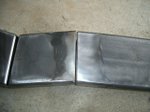Here is a look at the residential real estate market for Gwinnett County for the last two years as well as looking at overall trends that will affect investors and “move-up” buyers in the next few months.
Looking at the numbers up through June of 2007, there are a couple of trends that seem to be materializing. New listings are up year to date (YTD) about 15% over last year. May and June are up 11% and 9% respectively over the same period last year. The trend seems to be new listings returning to previous levels. At the same time, sold listings are down 25% YTD. In May and June, the sold listings are down 25% and 62% respectively. This trend is moving down, but I think that the June number is an anomaly. Another number I use is the percentage of “solds” leaving the market vs. new listings coming in to the market for a given month. This number is dropping pretty hard against last year. The YTD comparison puts it down by a third (32% vs. 49%). The last four months are down 36%, 34%, 38% and 22%.
So, we know that sales are down versus last year. However, prices have not yet followed suit. Prices for Gwinnett County are up 4% YTD v. last year. June was even up 7% in price against the same period last year, but I think that is also an anomaly. Time on the market, however, is up about 10 days comparing YTD numbers against last year.
Finally, looking at outside influences, I feel that there is a high likelihood that there will be an increase in foreclosure properties over the next few months. I think this increase will be more pronounced on the middle and higher end of the market. Many of these properties were financed with ARMs that were tied to volatile indexes such as the LIBOR. Owners may be faced with substantial increases in the housing costs leading to foreclosure. There has been a lot of activity in the market over the last couple of years, and so there are a lot of recent properties that could become troubled.
The first thing to keep in mind is that this ISN’T an overheated market like Southern California or Boston. There hasn’t been the huge run up in values in the last several years. In fact, the run up in many areas has barely kept pace with the increase in material costs to build a new house. Land has run up in many parts of the county as developers work to squeeze more homes into desirable areas. I think that infill has picked up as well. “Infill” is when builders tear out older homes and build one or more higher priced homes on the land.
What does this all mean? I think there are two distinct paths that will emerge in the coming months. The first path is in the entry and second step homes. I think that prices have largely stabilized. These homes don’t really have the room to move down, so at this time there are good deals available. The best deals are on “fixer-upper” homes in this range. These homes are stalled and sellers have to use price to make them sell. Foreclosures will start to get more attractive if the lenders start to get realistic about the prices. I see many of these homes priced well above comparable homes plus needed renovation (even with free labor). Until the prices on these properties drop down low enough to allow rehabilitation, these properties won’t sell in any significant number. There are some that are selling, but not to experienced investors or “flippers”. A good example is a home selling at $175k in a subdivision that should net $185k - $200k. The property needed around $20k in renovations to bring it up to area standards, not including most labor. A possible $5k profit is not sufficient for an investor to consider the property. That limits its market to investor/occupants. As the number of foreclosed properties increases, these limited buyers will dry up.
The second distinct path is for the higher priced properties. I see more profitable opportunities as prices move past $350k. There are fewer players in this area, and more properties showing up. This means that investors with deeper pockets or partnerships may be able to move up in the market and reap larger profits. An example of this is a property that I know of priced at $420k. It needs about $150k in renovation (including labor) to bring it to a standard that should allow a $700-$750k price. After carrying costs, there will be a profit of $100k-$200k. However, this will take a buyer with more substantial finances to exploit. The biggest danger in this realm is “under-furnishing” the property. The serious buyer of the renovated home will expect appropriate materials and finishes. If the investor tries to skimp on the details in one of these properties, they will not maximize the profit for the house.
Keep in mind that we look at these numbers in the rear view mirror. What that means is that we will know the market has turned when we see that it has already turned. We won’t know WHEN it will turn before it happens.
Feel free to email me for further info. I keep a pretty detailed spreadsheet with the statistics from FMLS that I use for these calculations.








No comments:
Post a Comment